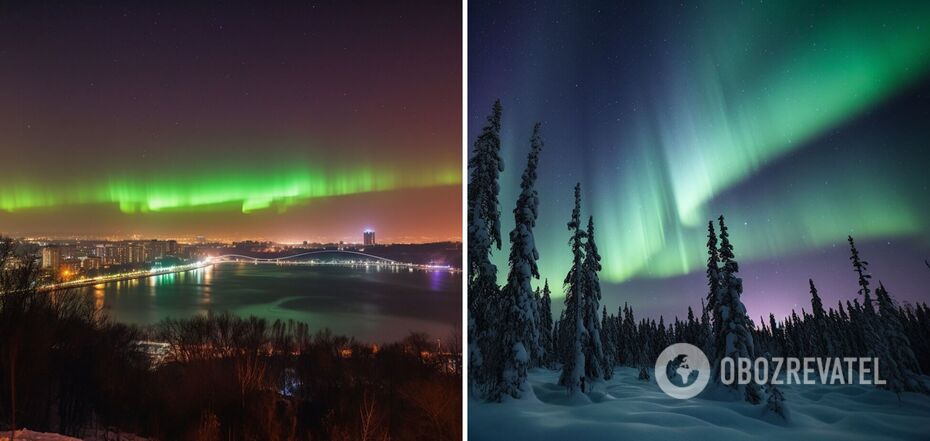Life
Why the northern lights appeared in Ukraine: what do world myths portend
The sudden appearance of the northern lights in the sky over some regions of Ukraine late in the evening on April 23 caused a strong reaction on social media. In addition to beautiful photos, people began to post various interpretations of what this celestial event could mean. Especially in a region where it is not typical at all.
OBOZREVATEL delved into the mythology of different nations to find out what it meant for the northern peoples. And what did southern ethnic groups, who rarely saw the aurora, think about the appearance of the aurora?
The Vikings believed that the aurora was an earthly manifestation of their gods. According to legend, the armour of the Valkyries shone in the sky as they accompanied the warriors to Valhalla, where Odin, the main god and ruler of Asgard, was waiting for them.
In other legends, it was believed that the glow was the breath of brave warriors who died in battle.
The Sami, an indigenous Finno-Ugric people, believed that the aurora was the souls of the dead. So it had to be respected. It was forbidden to sing under it, whistle or wave your hands. It was unacceptable to mention its appearance at all. It was believed that the shining could punish noisy people by coming down to Earth and cutting off their heads. Not surprisingly, the appearance of the northern lights was considered a bad omen.
In Finland, the northern lights are called revontulet, which literally means "fire fox". It is believed to be caused by wild arctic foxes that run so fast across the sky that they hit the mountains and create sparks that shine in the sky.
In Icelandic folklore, there is a belief that the northern lights help relieve pain during childbirth, but pregnant women were not supposed to look at them, otherwise the child could be born with crossed eyes.
In Greenland, people believed that the northern lights were the souls of children who had died in childbirth and were now dancing across the sky, and in Norway, the northern lights were the souls of old maidens dancing in the sky and waving to those below.
The Inuit of northern Greenland believed that the light was the spirits of the dead playing celestial games with walrus skulls, while other local Inuit communities believed that walruses played games with human skulls.
In North America, the aurora was believed to be either the souls of deceased ancestors or animal spirits. But it was not always friendly.
Some Native American tribes believed that the northern lights were torchlight in the hands of spirits who were charged with guiding the souls of the recently deceased over the abyss.
The Great Plains Indians also believed that the light was a reflection of great fires. These were the reflections of giant flames under the huge cauldrons that the northern tribes fired up to cook their enemies.
In Hudson Bay, Canada, they believed that the lights were the lanterns of demons that haunted lost souls.
In Alaska, the Inuit also feared the light and carried knives to protect themselves from the evil spirits of the aurora borealis.
Countries in southern Europe believed that the dancing blood-red streaks of the aurora borealis were an evil omen. The northern lights were perceived as a portent of war or other dangers.
For example, in the late 18th century, the outbreak of the French Revolution shook the country. A few weeks before the overthrow of the monarchy, a red aurora borealis appeared in the sky over England and Scotland, and people reported hearing huge armies fighting in the sky. Frightened eyewitnesses believed that this portended war and impending death.
The Scots called the northern lights the "Merry Dancers", depicting fallen angels or celestial warriors engaged in an epic battle.
However, not everyone saw the aurora as a harbinger of trouble. In many Northern European cultures, the aurora was seen as an auspicious sign. The Estonians believed that it was a beautiful sleigh carrying guests to a spectacular wedding in heaven.
Myths often explained the appearance of the aurora with stories about animals and nature. It was said that the northern lights appear when whales play. The Danes believed that it was caused by swans competing to see who could fly the furthest north. According to legend, some swans were trapped in ice and, trying to escape, flapped their wings, creating flashes of light in the sky.
Swedish fishermen looked forward to the aurora borealis because they believed that it was the reflection of giant shoals of herring sailing nearby. For them, the spectacle of the aurora brought good luck and promised a large catch.
In Greco-Roman mythology, it was believed that every day Aurora rushes across the sky in her chariot, announcing the beginning of a new day to her brother and sister, leaving behind a glow. In Latin, the northern lights are called Aurora Borealis: Aurora Borealis.
Previously OBOZREVATEL told how the northern lights appear in terms of science.
Subscribe to OBOZREVATEL's Telegram and Viber channels to keep up with the latest news.



























